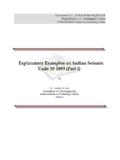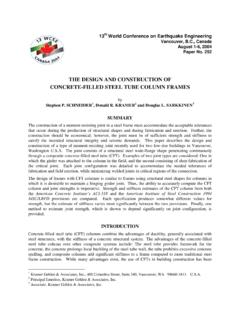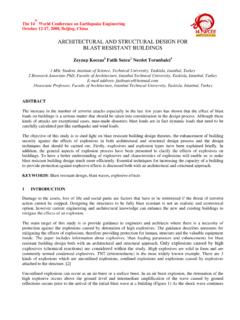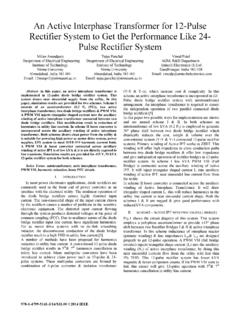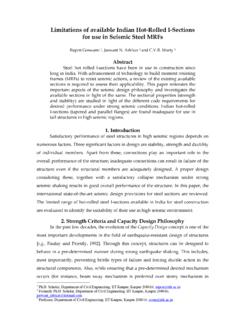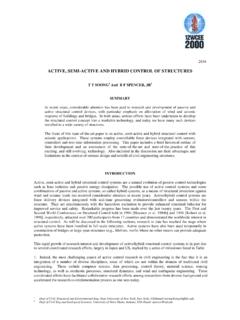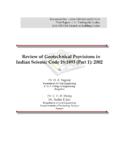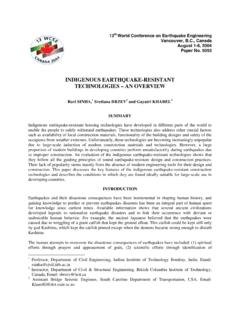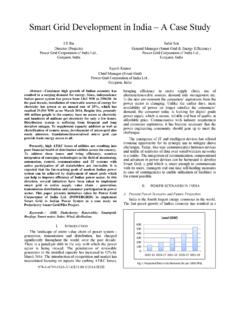Transcription of EFFECT OF THE TORSIONAL MOMENT ON THE …
1 08591 Dept of Architecture, Faculty of Engineering, Kogakuin University, Tokyo, Japan. Email: of Architecture, Faculty of Engineering, Kogakuin University, Tokyo, Japan. Email: of Architecture, Faculty of Engineering, Kogakuin University, Tokyo, Japan. Email: High School, Tokyo Institute of Technology, Tokyo, Japan. Email: OF THE TORSIONAL MOMENT ON THE SHEAR STRENGTH OFREINFORCED CONCRETE COLUMNS DUE TO ECCENTRIC JOINTING OFBEAM TO COLUMNJ iandong ZHOU1, Masaya HIROSAWA2, Tatsuya KONDO3 And Yasushi SHIMIZU4 SUMMARYIn this paper, the EFFECT of the TORSIONAL MOMENT , caused by the eccentric jointing of beam tocolumn, on the shear capacity of reinforced concrete column is discussed. Several typicalreinforced concrete structures damaged in the past few earthquakes are introduced. From theinspections of these damaged structures, it has been found that some columns in each of thesestructures were planned to joint beams to columns eccentrically.
2 The concrete cracks, caused bythe earthquakes, appeared spirally upwards round the surface of the columns, or developedobliquely along the whole length of the columns. These cracking patterns show that the columnfailure is a kind of the TORSIONAL failure caused by the combination of torsion and shear. On thebasis of the existing experimental results of 110 reinforced concrete specimens under the action ofthe torsion, a simplified formula is obtained, which has been taken account of the EFFECT of thetorsional span ratio, and could be used to predict the TORSIONAL capacity of rectangular reinforcedconcrete members in pure torsion. Furthermore another formula is also proposed, by which thereduction of shear capacity of reinforced concrete columns loaded by torsion and shearsimultaneously could be determined. The calculated results by these formulas have beencompared with experimental ones available in the literatures, and a good agreement has beennoted.
3 As a result, a particular consideration should be given to the influence of the eccentricity ofbeam - column joints on the shear capacity of columns, both in seismic evaluation of existingstructures and in seismic design of new reinforced concrete of building damages in earthquakes has proven that the TORSIONAL MOMENT due to eccentric beam-column joints has greatly reduced the shear capacity of the column [AIJ, 1998; Hirosawa and Zhou, 1998; Zhou,Hirosawa and Shimizu, 1998]. The TORSIONAL MOMENT becomes significantly large when a narrow wall girder iseccentrically jointed to the long side of a flat column. In the Kagoshima-ken Hokuseibu Earthquake both inMarch and May 1997, only reinforced concrete school buildings were severely damaged. Inspections andanalysis of the seismic damage have proven that some damages can be attributed to excessive TORSIONAL momentdue to eccentric beam-column joint [Zhou, Hirosawa and Shimizu, 1998].
4 Experimental results in the literaturessupported this conclusion by showing that the TORSIONAL MOMENT due to eccentric beam-column joints may reducethe shear capacity of the column from 30 to 40 percent [Morita, 1972; Hattori et al., 1970]. An inspection ofexisting reinforced concrete school buildings also showed that the building with eccentric beam-column jointsreached into 80 percent and increased as the date of completion became younger. The design without eccentricbeam-column joint is less than 20 percent in the recent medium height reinforced concrete study aims to discuss the evaluation of TORSIONAL MOMENT and its effecton the shear capacity of columns with eccentric beam-column joints byinspecting the damaged buildings in the past earthquakes and by referring thepast experimental DEVELOPMENT OF THE TORSIONAL MOMENTDUE TO THE ECCENTRIC JOINT AND THE EARTHQUAKEDAMAGES IN THE Development of TORSIONAL momentIn a column to which beams connected eccentrically, two couples of forces,as results of bending moments in the beams due to horizontal load, act at theportion apart a distance e from the column center (see also in Figure 1).
5 In acondition without the TORSIONAL deformation of the column at the floor slablevel, an eccentric MOMENT Mj=(T+C)e works at the bottom bar level of the beam and can be shared as thetorsional moments of the joint zone and the column as well as the out-of-plane bending MOMENT of orthogonalgirders at the top of the column. Setting the TORSIONAL moments at the top of the column and the joint zone as Mtcand Mtj respectively, we have Mtc/Mtj=j/ho' neglecting the confining EFFECT of the orthogonal beams on the TORSIONAL MOMENT works in the column can be approximately given byeQcMtc (1)where Qc is the shear force working on the column and e is the eccentric distance between the beam and Earthquake damages in the Hakodate UniversityThe main building of Hakodate University was damaged by the 1968 Tokachi-oki Earthquake [AIJ, 1968] asshown in , and the dimensions of the column and the beam are shown in Figure 2 (a).
6 Cracks of this typewere found in the first and the second floor. The diagonal cracks extended from one side to the adjacent side toform a helical shape. This type of failure may be attributed to pure torsion [AIJ, 1991]. Inatori Junior High SchoolColumns of Inatori Junior High School damaged by the 1978 Izu-Oshima Earthquake are shown in Photo. 2 Figure 1: TORSIONAL momentdue to eccentric beam-column jointPhoto. 1: Buildingdamaged by the1968 Tokachi-okiearthquakePhoto. 2: Buildingdamaged by the1978 Izu-OshimaearthquakePhoto. 3: Buildingdamaged by the1995 Hyogo-kenNanbu earthquakePhoto. 4: Buildingdamaged by 1997 Kagoshima-kenHokuseibuearthquakePhoto. 5: Buildingdamaged by 1997 Kagoshima-kenHokuseibuearthquake b s .. o f l l l 08593[AIJ, 1980], and the dimensions of the column and the beam are shown in Figure 2 (b). The helical cracksextended over the adjacent sides implying the EFFECT of Amagasaki High SchoolBuilding of Amagasaki High School was damaged by the 1995 Hyogo-ken Nanbu Earthquake [Ishibashi et al.]
7 ,1995] as shown in , and the dimensions of column and beam are shown in Figure 2 (c). The diagonalcracks extended over the internal height of the column implying the shear type TORSIONAL failure [AIJ, 1991]. Miyanojo Agricultural High School and Sendai High SchoolBuilding of Miyanojo Agricultural High School and Sendai High School were damaged by the 1997 Kagoshima-ken Hokuseibu Earthquake [Tokuhiro et al., 1998] as shown in and 5, and the dimensions of column andbeam are shown in Figure 2 (d). These cracks are also helical implying the presence of with noticeable damages are mentioned and the dimensions of columns and beams and their eccentricjoints are shown in Figure 2. Structural conditions common to these columns under TORSIONAL and shear-failureare as ) Beams were eccentrically jointed to ) Spacing of the column hoop was so wide since the design was based on the former structural ) Clear span ratio of the columns was intermediate (ho/D 4).
8 D) The columns were rigidly framed in two TORSIONAL failure examples were the result of restricted inspection therefore significant number of examplesmight have been CAPACITY OF RC MEMBERS SUBJECTED TO TORSIONAND VERIFICATION OF THE EXPERIMENTAL DATA IN THE PAST Verification of experimental data of members subjected to pure torsionMany studies used beams preferably to investigate the structural performance of reinforced concrete memberssubjected to TORSIONAL stress, and in experiments, simple rectangular cross section has been often on the pure torsion of columns are very few. However, a column and beam with a rectangular crosssection can be regarded to show similar behavior if the EFFECT of axial load can be neglected. In this study,behavior of column under TORSIONAL stress is inferred by that of beams, which has been documented in 8literatures with 110 specimens [Kanou and Nakayama, 1965; Kanou and Ishiguri, 1982; Kanou and Takemura,1983; Nakayama and Kanou, 1975; Tomii et al.]
9 , 1965; Wada and Kanou, 1969; Wang and Kang, 1988; Yamadaand Tamura, 1968]. Conditions of the beam specimens are shown in Table 1.(b) Building of Inatori JuniorHigh School(a) Building of HakodateUniversity (c) Building of AmagasakiHigh School (d) Building of MiyanojoAgricultural High SchoolFigure 2: Dimension of the column and beam with eccentric joint damaged by past earthquake2006001207501,940500800250 5502,3006008007001209801,800400700250 4501201,0801,300600350180 (a/D) large number of formulas have been proposed toestimate the pure TORSIONAL capacity of the reinforcedconcrete member, Mto, which is a sum of the concretestrength term and TORSIONAL reinforcement term asshown in the following equation [AIJ, 1991].()DBpMto2wywt11B1 + = (2)where B is the compressive strength of concrete inkgf/cm2, pwt and wy are the TORSIONAL reinforcementratio and its yield point strength, B and D are the shortand long dimension of the rectangular cross section of acolumn in cm, and 1, 1, 1 are constants to bedetermined in the other hand, the past experiments [Nakayamaand Kanou, 1975; Kanou and Ishiguri, 1982; Kanouand Nakayama, 1965; Yamada and Tamura, 1968] have shown that EFFECT of the TORSIONAL span ratio upon thepure TORSIONAL capacity is significant.
10 It is shown in Figure 3. The relationship between the TORSIONAL stress andthe TORSIONAL reinforcement ratio is shown in Figure 4. It can be seen that the TORSIONAL reinforcement can increasethe TORSIONAL capacity within a restricted range ( ) but no further improvement is expected outside ofthe range. Therefore, we propose the following formula (3) that can give a practical TORSIONAL capacity taking intoaccount of the TORSIONAL span ratio.() += (3)where pwt is less than and a is the net length of a member subjected to proposed equation (3) was applied to the experimental results of members subjected to pure torsion and thecalculated values showed good agreement with the experimental results as shown in Figure 5. Average ratio ofcalculated and experimental value was and the coefficient of variation was Verification of experimental data of members subjected to TORSIONAL and axial loadIt was experimentally confirmed that the axial load has great influence on the pure TORSIONAL capacity ofreinforced concrete members.
